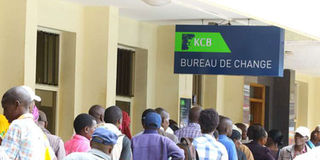Why repeal of interest rate caps could spur economic activity

Kenya Commercial Bank customers queue to withdraw cash from an ATM machine in Kisii on May 2, 2017. Banks need to offer better-priced loans by reducing their charges. PHOTO | BENSON MOMANYI | NATION MEDIA GROUP
What you need to know:
- There seems to be a consensus that the caps have failed to lower the cost of credit and increase lending to the private sector.
- The financial distress of the banks is exacerbated by the huge debts the national and county governments owe suppliers.
After a gloomy 18 months, banks are finally grinning in anticipation of the interest rate caps imposed by the government being lifted, most likely around budget time in June.
There seems to be a consensus that the caps have failed to lower the cost of credit and increase lending to the private sector.
The overwhelming public support evident on August 2016, when President Uhuru Kenyatta signed the Banking (Amendment) Bill, 2015 empowering the Central Bank of Kenya to regulate interest rates within a seven per cent spread between lending and deposit rates, has faded.
BANKS COLLAPSE
As banks continue to lend to large businesses, small enterprises and individuals are suffering from lack of credit.
This segment is so squeezed that businesses have either shutdown or are operating on the edge, supported by short-term borrowing from the more expensive alternatives.
But while the President was categorical that it was time to rein in the banks for being irresponsible in their pricing of credit and stifling financial inclusion, a few fundamental flaws contributed to the failure of the spirit in which the regulation was imposed.
First, the market was badly shaken then by the collapse of Chase Bank, Imperial Bank and Dubai Bank.
The crisis of confidence hit the medium and small banks like a thunderbolt as customers hedged their positions by shifting their deposits to the large banks.
CHALLENGES
Concentration of lending power has its consequences, as the large banks tend to lend to big clients and invest surplus funds in the more attractive and secure Treasury bills.
Second, the liquidity of the banks was under pressure from rising debts of their clientele.
Risks from non-performing loans increased last year and continue to significantly affect the bottom line of most banks.
Several factors contributed to this, including poor economic prospects due to heavy political activity and the massive debts accumulated by Kenya Airways, Nakumatt, Uchumi and other large enterprises that suffered huge trading losses due to fraud and mismanagement.
The financial distress of the banks is exacerbated by the huge debts the national and county governments owe suppliers.
DEBT
Counties reportedly owe contractors and other suppliers of goods and services more than Sh100 billion and aren’t making much effort to pay up.
Third, the banks conspired to ensure the interest rate caps failed by being more selective on their borrowers and increasing non-interest fees and charges.
This enabled them to narrow down their lending to quality clients and also contribute to their free liquidity (such as trading enterprises that have regular daily cash flow) and load charges such as credit appraisal and insurance fees — legally.
These charges, collected before loan disbursement, are so significant that they push the cost of credit from the regulated 14 per cent per annum to over 18-24 per cent per annum.
Now that the CBK has adjusted its benchmark rate to 9.5 per cent, the regulated lending rate will drop to 13.5 per cent.
However, the real cost of loans will remain high due to the additional charges.
CREDIT
Lifting the caps would, certainly, return the banking sector to free market enterprise, improve the banks’ margins and enable them to expand credit to the private sector.
The banks should support the President’s ‘Big Four’ agenda by increasing credit to manufacturing, housing development and agribusiness.
They need to offer better-priced loans by reducing their charges.
The government, too, should ease the pain of the banks and borrowers by borrowing less from the money market to stop crowding out the private sector.
It should also ensure timely payment of suppliers.
Otherwise, it will kill the geese that lay the golden eggs, making the ‘Big Four’ difficult to achieve.
Mr Warutere is a director of Mashariki Communications Ltd. [email protected]





